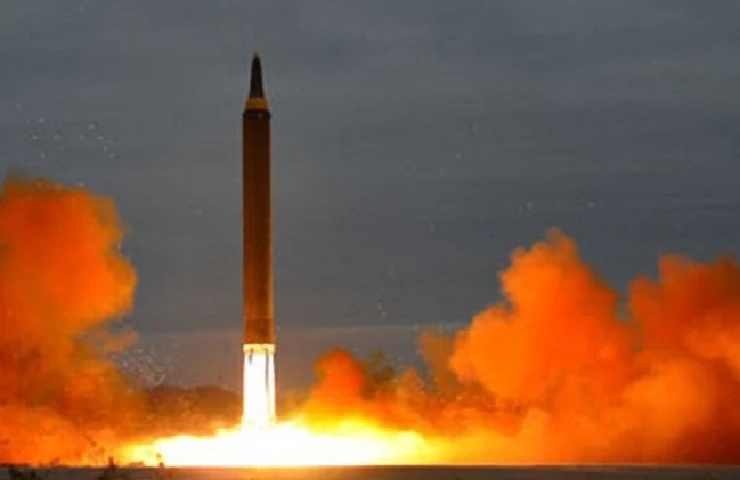Until last year, China had only 16 known silos for its latest-generation inter-continental ballistic missiles (ICBMs) and scarcely 200 warheads, according to the American Department of Defence.
Now, satellite imagery has revealed that in the desert of Gansu province, 120 new silos are being built near western China.
The lack of any official Chinese confirmation or explanation, along with introduction of air-based nuclear capabilities and construction of more road-mobile ICBMs and strategic nuclear submarines, have all contributed to confusion and suspicions about Beijing’s intentions.
Researcher James Martin, who works at Centre for Nonproliferation Studies, an American think-tank, has identified the silos near the city of Yumen and his findings were published by the Washington Post.
It is being theorised by these researchers and other experts that China's latest ICBM, the DF-41, will be housed in these newly built silos and can virtually reach all of America. Another research group, the Federation of American Scientists (FAS) has spotted near the city of Hami, in eastern Xinjiang around 110 silos being built by China by poring over satellite imagery from Planet, an American firm.
This is in stark contrast from China's earlier policy of “minimum deterrence”, that has involved maintaining a relatively small arsenal that would allow to defend against aggressors, but not wage an elaborate and offensive nuclear war. China has also foregone its traditional focus on quality by procuring a large number of strategic nuclear submarines of its existing model, the 094 class which indicates China wants to utilize its unique advantages in industrial manufacturing and large-scale infrastructure to bolster its non-mobile silo-based nuclear capabilities. In other words, the Chinese are working on all dimensions of the nuclear triad by acquiring the capability to deliver atomic weapons from land, air and sea.
The shift in strategy results from fear that China’s meagre nuclear forces can be wiped out by America’s large and precise arsenal and a lack of direct commitment by America to not direct its missile defence systems towards China. The layout of the Chinese shelters may suggest that it is trying to move its missiles underground between silos, so that America may not know which ones to strike during a conflict.
The Economist reports that this strategy is reminiscent of the "shell game" magician trick, where a ball is placed under one of three cups, which are then shuffled to deceive the viewer about the location of the ball.
This view is supported by a member of Carnegie Endowment, an American think-tank, James Acton who argues that China would not have enough fissile material to fill all the new silos because the country had stopped producing plutonium in the 1980s and there is little evidence that production has resumed. Another argument for the same is that the silos built in Gansu are just 3 km apart compared to the ones in Jilantai, where China's older silos are tens of kilometres apart.
Critics of the "shell game" theory argue that it is naive to assume that China is building them as minimum deterrent since for some time China has been dramatically expanding its nuclear forces with the annual report on Chinese military power by the pentagon stating that the warhead stockpile would double in size over the next decade. Since each missile can carry more than one nuclear warhead, 230 new silos can theoretically support the deployment of several hundred warheads and perhaps more. Admiral Charles Richard, who is the head of Strategic Command stated in April 2021 that intelligence being gathered was becoming out of date within a month due to the rapid advance of China's programme.
Experts suggest China will fire its missiles at the first sign of a nuclear strike, since Silo-based ICBMs can be launched more rapidly than ones carried on mobile launchers, which have to be fueled after being erected. It is pertinent to note that as of now, China does not keep any weapons on high alert, ready to launch at a moment’s notice.
There is a last remaining arms-control pact between America and Russia that was renewed in February and will expire in five years called the New Start treaty that involves verifying weapon arsenal by sending inspectors to peer into one another’s silos. Carnegie Endowment, a think tank reports that China may be included in any future arms-control measures if America views the new silos as confirmation of a rapid nuclear expansion, although China is reticent about exposing its arsenal to scrutiny.
China has also dismissed revelations regarding the silos through its media platforms by stating that the missile silos are actually windmills on a wind farm and reports by U.S. agencies are attempts to demonize China. The Biden administration wants China to open talks about its own arsenal, although both countries have several times more warheads than China. Hence, the "shell game" interpretation, even though the most benign, is least encouraging for arms control as China’s plan to shuffle missiles around would make it much harder for others to be certain of its deployment. This belligerent act of China is, in a manner, a confirmation of how uninterested it is in subscribing to any arms control treaty.




















